Boston: Hub City of American Audio
The home of the bean and the cod has also been the home of an inordinate amount of high fidelity innovation.
by Michael Riggs
---------------- Michael Riggs is by profession an investment counselor and by avocation the editor-in-chief of the Boston Audio Society's monthly journal, The BAS Speaker.
--------------
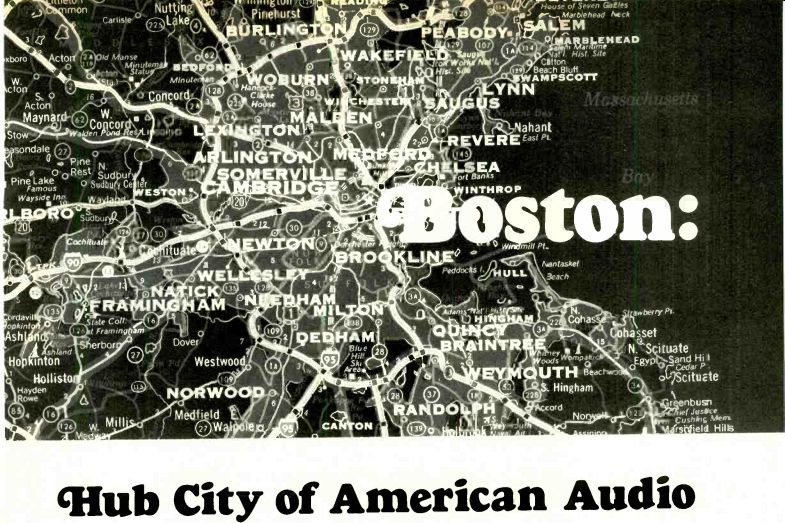
SEVERAL YEARS AGO, when I moved from the heart land of America (St. Louis, to be precise) to Boston, I was a budding audiophile with no very clear notion of what the city would be like. I knew, of course, that there was a Boston Symphony Orchestra, that Harvard and MIT were here, that some good loudspeakers called it home, and that some thing called the Boston Audio Society was just be ginning to make itself known to the world. Once settled in, my first move was to join the Audio Society, which proceeded to educate me about high fidelity and about the remarkable city in which I live. Boston, it turns out, is a hotbed of audio activity. For the audiophile, there is no place more exciting.
Two sources converge to make audio in The Hub City the adventure it is. The first is the deep well of talent and technical expertise in the metropolitan area. Boston, Cambridge (her sister city across the Charles River), and the suburbs are home to some thirty colleges and universities and to an impressive number of high-technology industries. Twenty-odd audio manufacturers of one stripe or another-probably a higher per-capita concentration than any other metropolitan area in the world can claim-are native to the Boston area, including such old-timers as Acoustic Research, KLH, and H. H. Scott. Whatever the need, if it's within the reach of current technology, it either could be or is being produced here.
But hardware can only reproduce music, and the love of reproduced music can come only from the love of music itself. Boston and environs over flow with music of every kind. The core of this ac tivity is the Boston Symphony Orchestra, flanked by the astonishing Sarah Caldwell and her Boston Opera Company and by the New England Con servatory. A relatively large number of clubs feature jazz groups, many of them home-grown, and FM stations WBUR, WGBH, and WHRB pro gram jazz on a regular basis. The Berklee School of Music is probably the country's major institution devoted solely to the teaching of jazz and popular music. Cambridge, in particular, has maintained a strong folk and blues scene. On a clear day, you can hear bagpipes in Harvard Square. It takes a large, musically aware population to nourish such variety. It is not by accident that the SCHWANN CATALOG has been prepared in Boston during the nearly three decades it has been published [for more on SCHWANN, see the editorial on page 4. Ed.] nor that Bolt, Beranek, & Newman, the Boston firm of acousticians, has dominated its field for much of that period.
That diversity is a source of special delight to the audiophile, however, because he has a way of keeping in touch with it that others do not fully appreciate. FM in Boston is exceptional in the scope and quality of its live broadcasting. Four stations WBCN, WBUR, WCRB, and WGBH-do significant amounts of live broadcasting, with WCRB and WGBH regularly transmitting Boston Symphony concerts to thousands. WCRB is the producer and distributor of the BSO tapes, and has recently assumed the same role for the New York Philharmonic, whose concerts it also broadcasts. This musically active station also duplicates and distributes the tapes of the Chicago Symphony produced by WFMT.
The outstanding sonics of the BSO broadcasts are no accident, and the fact that they really are top notch (often better than the Symphony's recordings) is not as surprising as it would be in most places. Bostonians have been involved in the development and refinement of stereo FM broad cast and reception from the beginning. Daniel von Recklinghausen (then of H. H. Scott, now of KLH) worked closely with the FCC when the stereo multiplexing system now in use was chosen, designed one of the first stereo generators, helped stations all over the country set up and align their generators, and supervised the design of the first stereo tuners that really worked. Later KLH built the first high-quality solid-state tuner. More recently the interesting work has been at the other end of the chain. Some WGBH broadcasts probably represent the highest FM fidelity in the nation today.
The moving force behind these broadcasts is AR's Victor Campos. Early in his Adventures in Sound series he demonstrated that FM could be an extraordinarily high fidelity medium if all automatic limiters and compressors are removed from the signal path. This makes necessary a small amount of manual gain riding to prevent over-modulation, but it results in a cleaner signal with much improved dynamic range. The program material for Adventures in Sound consists of Dolby-A encoded dubs from master tapes. Decoding ...
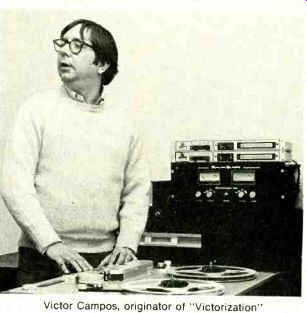
------ Victor Campos, originator of "Victorization"
...doesn't occur until the signal reaches the transmitter, thus minimizing noise from the phone lines between the studio and the transmitter. The resulting sound through a good tuner is stunning.
WGBH also uses this process-affectionately called "Victorization" (after Campos) by Bostonians-on many of its BSO broadcasts, with similar results. Boston may be the only city in the country where it makes sense to spend the money for a state-of-the-art tuner.
The technical aspects of high fidelity are covered by radio as well. Saturday mornings on WBUR, Peter Mitchell and Dick Goldwater are hosts of Shop Talk. They frequently have guests and always have interesting discussions. The pro gram is one of the things that give the local audiophile community its definition.
The other shaping force is the Boston Audio Society, probably the largest and the most active audiophile organization in the world. Founded four years ago by Alvin Foster and a handful of de votees, it has doubled in size every year until it now has about eight hundred members, some as far away as Japan and Australia. Of course people don't (usually) come from the ends of the earth to attend monthly meetings. In a sense, the meetings go to them. The vehicle is The BAS Speaker, the house organ. More than any other audiophile publication, it is a collective effort, a forum for the membership. Hundreds of people of every conceivable background, from astrophysicists and audio manufacturers to housewives and students, even when separated by continents or oceans, participate in lively, informed discussion.
The society's meetings most often feature a lecturer from the industry, sometimes a member with an idea or demonstration to present, and occasionally both. (Sometimes it's the same person.) Unlike many organizations, the BAS is not monolithic in outlook or philosophy. The tie that binds is concern.
The upshot is that members develop un commonly good sense about equipment. They also arrive at some unconventional conclusions and some remarkably effective ways to make things better. The lately renewed interest in damped tone arms stems largely from investigations and experiments by members. Phono preamps, which long have eluded the engineers' quest for measurements that correlate with sonic quality, may be yielding to the efforts of a number of members.
Others have reported on the audible (or inaudible) effects of phase shift and on the desirability of infrasonic filtering. No one denies that new knowledge and techniques are emerging from the continuing debates.
This same spirit of skeptical inquiry extends into the local audio industry, as was evident during a recent BAS tour of Acoustic Research's Nor wood facility. AR's position in the history of high fidelity is well established. Edgar Villchur's acoustic-suspension principle was, perhaps, crucial in making stereo commercially viable. The suspension system he developed for the AR turntable has been widely imitated, and when AR got around to introducing a line of electronics, they were among the best available. (A BAS clinic revealed that the AR tuner performs very well even in comparison with today's high-performance phase-locked-loop tuners.) And AR hasn't stopped its extensive research and development activities. The BAS was shown the anechoic and reverberant chambers that AR uses in loudspeaker development. Rising interest in car stereo has prompted the use of real-time ...
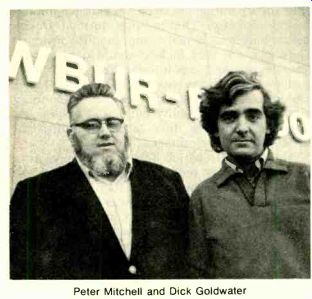
----------- Peter Mitchell and Dick Goldwater
...analyzers to investigate the acoustics of automobile interiors, with an eye to developing a small speaker for installation in cars. Another project involves computer analysis of the impulse responses of loudspeakers. AR hopes that information will help to determine the significance (if any) of a speaker's impulse response characteristics. AR's new line of loudspeakers is the outgrowth of re search on crossover design and driver development, which includes ongoing work in plastic-cone units.
AR is also actively pursuing psychoacoustic re search, on the one hand to determine the lower limit of distortion audibility with various kinds of signals and on the other to find ways to simulate the acoustics of concert halls. This has led to a six teen-channel, computerized, digital audio-delay line for use as a research tool. There has been a persistent rumor (which AR persistently denies) that it is planning to market a home delay system.
AR's offspring-KLH, Advent, and Allison among them-continue to be innovative as well.
KLH has introduced a line of loudspeakers, some of which incorporate a newly developed tweeter.
Despite appearances (it resembles an electrostatic element), it's an electromagnetic device. The designer was Von Recklinghausen, who claims excellent transient response, extraordinarily smooth frequency response out to 30 kHz, and far greater power-handling capacity than any other tweeter.
A problem most designers have ignored, or at least treated as an imponderable fact of life, is that room acoustics seriously affect a loudspeaker's output, especially in the bass region, where room res onances play a prominent role. Roy Allison did much quantitative research, first at AR and later with his own company, into the interaction of speakers with room boundaries. This led him to design speakers that use room effects in a positive way. Allison Acoustics' loudspeakers, when placed properly, have much flatter bass response in typical rooms than most other models. This is the sort of audio work that Boston prides itself on: an effective and practical solution to a problem everyone--not just "golden ears"--can hear.
Advent Corporation (Henry Kloss, Advent's founder, was a central figure in both AR and KLH) has a reputation for taking a pragmatic approach to audio. It is best known for its loudspeakers, but Kloss actually founded the company to develop his idea for a large-screen, "high fidelity" tele vision receiver, now dubbed the VideoBeam. Ad vent also did more than any other single manufacturer to make the cassette a high fidelity medium and to promote the Dolby-B noise-reduction sys tem. It was the first company to distribute chromium-dioxide cassettes, the first to manufacture a high quality cassette deck with both Dolby noise-reduction circuitry and provisions for chromium dioxide, and the first to market a separate Dolby-B...
-------------
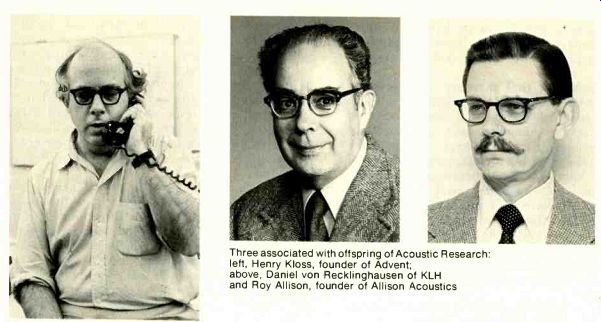
Three associated with offspring of Acoustic Research: left, Henry Kloss, founder of Advent, above, Daniel von Recklinghausen of KLH and Roy Allison, founder of Allison Acoustics
----------------------
...unit. Its latest product, the Model 300 receiver (among our test reports this month), is the result of much investigation into the behavior of tuner, amp, and preamp electronics under normal conditions. Among its most exciting features is a state of-the-art phono preamplifier (in a $250 receiver!) said to sound as good as any separate unit avail able. Advent's published reports on its work have done much to remove the mystery from preamp design.
Recently a new speaker manufacturer has been making itself heard: Cizek Audio Systems, founded by Roy Cizek, longtime BAS member. Cizek's looks similar to many other acoustic-suspension loudspeakers, but it has exceptionally flat response and incorporates several innovations, among them unusually flexible response-shaping controls and a crossover network that presents an almost flat impedance curve to the driving amplifier.
Other influential Boston-area loudspeaker de signers include Arthur Janszen, one of the fathers of modern electrostatic speakers and the designer of the classic KLH 9, and the late Victor Brociner, who had a long, distinguished career in audio and was the creator of the Avid line. The people responsible for the Genesis speakers got their start with Boston manufacturers. Winslow Burhoe, formerly of KLH and later founder of Epicure, has gone on to start the Little Speaker Company.
Meanwhile, the Epicure group, having designed and marketed a diverse line of loudspeakers, has entered the electronics field with a top quality amplifier and a matching preamp.
Another innovative company, headed by MIT ,professor Amar Bose, has extended its speaker line down to the little 301. In the other direction, its latest version of the Bose 901 system, on which the company's fame was founded, has taken it into materials and, particularly, technologies far be yond the purview of most speaker companies.
Critical considerations of aerodynamics and ultra high-precision plastics molding and coil windings had to be mastered before the Series UI could reach production. Bose also has entered the amplifier market with the Model 1801, whose design parameters were selected according to the results of psychoacoustic research.
Dunlap-Clarke, for several years a manufacturer of state-of-the-art power amplifiers devised with particular attention to the problems of driving difficult loudspeaker loads, has introduced a preamplifier incorporating the latest advances in phono preamp circuitry. The recently formed Davis Brinton makes a phono-preamp module designed to produce the very highest sound quality possible; its preamp plugs into the high-level inputs of an amplifier or receiver. Mark Davis and James Brinton have used new test procedures and design principles, highest quality parts, and a specially structured bandpass filter to insure consistent state-of-the-art performance.
Another field in which Boston companies have led the way is noise reduction. Kloss, when he was president of KLH, encouraged Ray Dolby to develop the Dolby-B system and was the first to use it. Most of Dolby's competition comes from DBX another Boston company. Its first consumer products were sophisticated companders, intended mainly to restore dynamics lost through compression and only secondarily to provide moderate noise reduction for recordists. Later it introduced noise-reduction devices that, while delivering an even greater dynamic range than Dolby's, are easier to use. Recently DBX began selling circuit boards that are plug-in replacements for Dolby-A boards, making the DBX system conveniently available to Dolby-equipped professional recordists and studios at minimum cost. The company continues to promote DBX-encoded discs. At the same time, Burwen Labs (now a part of KLH) has developed a variable bandpass filter-the Model 1201--that works on a principle originating with H.H. Scott in the early Fifties. The 1201 achieves about the same degree of noise reduction as the Dolby-B system, but without the need for specially encoded program material.
Arguably the most exciting new idea in audio is ambience simulation. Here again, Boston is the un challenged leader. The only two companies making a serious effort in this direction, Sound Concepts and Audio Pulse, are located in this area.
Their audio delay lines have, without quadraphony (and without need of special program material), produced at least as good an illusion of acoustic space. The Sound Concepts SD-50 and the Audio Pulse Model One, and the ideas behind them, promise to leave a deep imprint in the history of high fidelity.
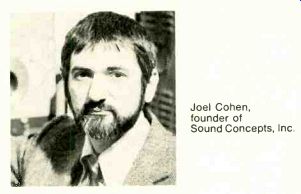
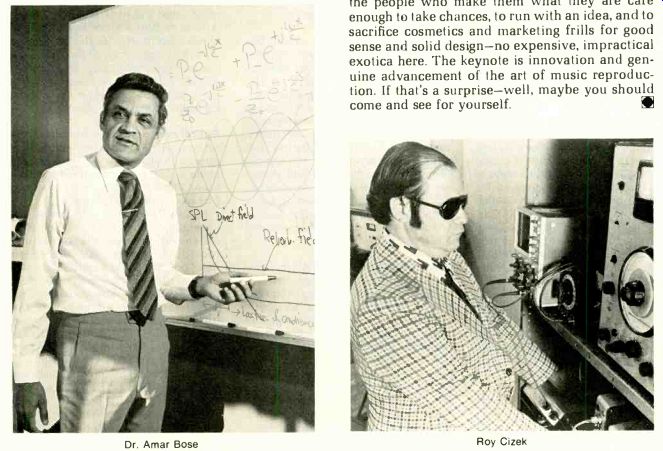
----------------- Dr. Amar Bose. Joel Cohen, founder of Sound Concepts,
Inc. Roy Cizek.
A complete list of Boston-area audio-related companies runs the gamut from the U.S. head quarters of BASF (a sprawling international structure with interests far beyond the recording tape with which we associate its name) to Source Engineering (a modest company that is just beginning to produce yet another type of noise-reduction equipment and the only current consumer preamp designed specifically to solve the problems of the antique-record collector). The audiophile com munity also has been witness to and participant in the rise of true high fidelity in car stereo, as led by ADS.
Boston isn't just another big city with a clot of high fidelity manufacturers. The companies and the people who make them what they are care enough to take chances, to run with an idea, and to sacrifice cosmetics and marketing frills for good sense and solid design-no expensive, impractical exotica here. The keynote is innovation and genuine advancement of the art of music reproduction. If that's a surprise-well, maybe you should come and see for yourself.
-------------
(High Fidelity, March 1977)
Also see:
Letters to the editor, March 1977